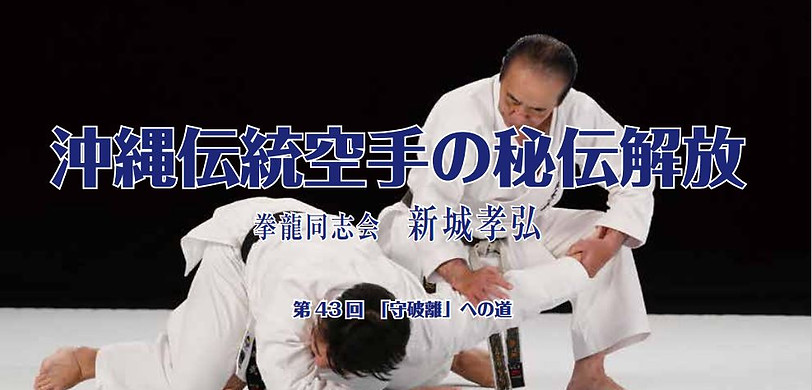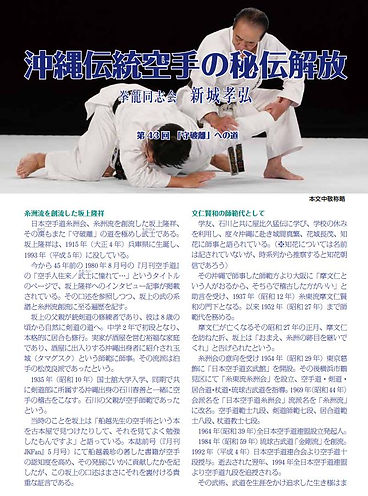
The Liberation of Okinawa Traditional
Karate’s Secret Techniques
A Courtesy of the Monthly Magazine "JKFan"
By Takahiro Shinjo
Translated by Ayumu Oda

Ryusho Sakagami, Founder of Itosu-ryu
Ryusho Sakagami, who founded the Japan Karate-do Itosu-kai and the Itosu-ryu style,
was also a true bushi—a warrior who mastered the path of "Shuhari" (the concept of learning, breaking, and transcending tradition).
Sakagami was born in 1915 (Taisho 4) in Hyogo Prefecture and passed away in 1993 (Heisei 5).
An interview with Sakagami appeared 45 years ago in the August 1980 issue of Monthly Karate-do, in a section titled “Karate People: Admiring the Way of the Samurai.” Drawing from that oral account, this article traces his martial lineage and the path that led him to found Itosu-ryu.
Sakagami’s father practiced Jukendo (bayonet fighting), so Sakagami naturally began learning kendo around the age of 8. He attained shodan (first-degree black belt) by the second year of junior high and also began studying iaido seriously. Coming from a wealthy family that ran a sake shop, he was introduced to a teacher named Tamagusuku through Okinawans who frequented the shop. Tamagusuku belonged to the Matsumora-ha style of Tomari-te.
In 1935 (Showa 10), Sakagami enrolled in Kokushikan University, where he joined the kendo club with his Okinawan friend Haruyoshi Ishikawa. They also trained in karate together; Ishikawa’s father was a karate master.
Sakagami said of that time, “I found a book called ‘Karate-jutsu by Master Funakoshi’ at a used bookstore and studied it diligently.” The previous issue of this magazine (Monthly JKFan, May) discussed how Gichin Funakoshi’s publications contributed to the spread and development of karate. Sakagami’s words affirm this point as a valuable firsthand testimony.
Assistant Instructor (Shihan-dai) Under Mabuni Kenwa
Together with his classmate Ishikawa, Sakagami studied under Moden Yabiku. During school holidays, he often traveled to Okinawa to train under Gusukuma Shinpan, Hanashiro Chomo, and Chibana (likely Chibana Choshin, based on the timeline).
His Okinawan teachers advised him, “There’s a man named Mabuni in Osaka. You should train with him.” Taking their advice, he became a student of Kenwa Mabuni of Shito-ryu in 1937 (Showa 12) and served as his assistant instructor until 1952 (Showa 27).
In the New Year of 1952, just before Mabuni’s death, Sakagami visited him and was reportedly told: “You must inherit the legacy of Itosu.”
Following the wishes of the Itosu-kai, Sakagami opened the Japan Karate-do Genbukan in Katsushika, Tokyo in 1954 (Showa 29). Later, he established the Shito-ryu Itosu-kai in Tsurumi Ward, Yokohama, where he taught karate-do, kendo, iaido, jodo, and Ryukyu kobudo.
In 1969 (Showa 44), the organization was renamed Japan Karate-do Itosu-kai, and the style officially became known as Itosu-ryu.
His ranks include:
-
Hanshi 9th dan in Karate
-
Kendo Hanshi 7th dan
-
Iaido Hanshi 8th dan
-
Jodo Kyoshi 7th dan
In 1964 (Showa 39), he was a founding member of the Japan Karatedo Federation.
In 1984 (Showa 59), he established the Kongo-ryu style of Ryukyu kobudo.
In 1992 (Heisei 4), he was awarded the 10th dan in Karate-do by the Japan Karatedo Rengo-kai, and after his passing in 1993, he was posthumously awarded the 9th dan by Japan Karatedo Federation in 1994.
His life was dedicated to the lifelong pursuit of martial arts and budo.
At the end of his interview, Sakagami offered some critical words to the modern karate world, sounding an important warning:
“Sure, thanks to the development of kumite competitions, karate has become incredibly popular. But even in kendo, beyond just hitting with bamboo swords, they still practice the classical kata. Karate kata too should be preserved in their traditional form. These days, some people just change or invent new kata as they please. That’s not right. One of Itosu-sensei’s ten precepts includes: ‘Do not add embellishments.’
Now more than ever, I want to say—return to kata as the essence of karate!”
Takahiro Shinjo (Writer)
Born in 1956 in Miyako District, Okinawa, and raised in Koza City (now Okinawa City), Shinjo’s journey in karate began at the age of 14 when he joined a Motobu-ryu dojo under the influence of his older brother. He later studied under Matsumura Orthodox Shorin-ryu and trained in Tomari-te under Masataka Toma while serving as an instructor. He also trained with Yoshio Kuba of Goju-ryu, and in Shotokan through the Japan Karate Association. He has in-depth knowledge of at least five different styles.




